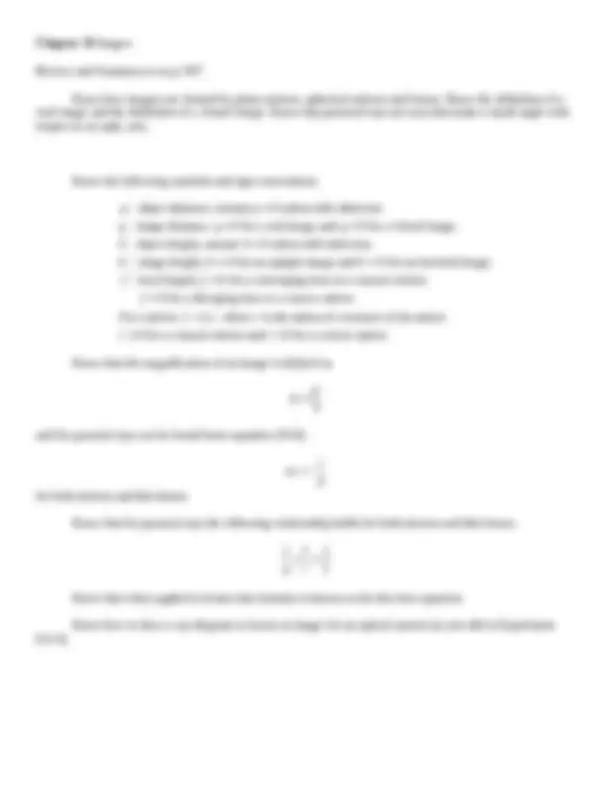



Study with the several resources on Docsity

Earn points by helping other students or get them with a premium plan


Prepare for your exams
Study with the several resources on Docsity

Earn points to download
Earn points by helping other students or get them with a premium plan
Community
Ask the community for help and clear up your study doubts
Discover the best universities in your country according to Docsity users
Free resources
Download our free guides on studying techniques, anxiety management strategies, and thesis advice from Docsity tutors
These are the notes for test 6 of physics 241, covering chapter 33 on electromagnetic waves and chapter 34 on images. Topics include the properties of electromagnetic waves, polarization, intensity, pressure, reflection and refraction, geometrical optics, lenses, and mirror images. Key concepts are explained with formulas, equations, and diagrams.
Typology: Study notes
1 / 3

This page cannot be seen from the preview
Don't miss anything!


Notes for Test 6
Chapter 33 Electromagnetic Waves
Review and Summary is on p. 913.
Know what is meant by an electromagnetic plane wave. Know that for this wave, the electric and
magnetic field vectors are in phase and that E B points in the direction of propagation of the wave. (See
Figure 33-5.) Know that if this wave is traveling in the direction of the + x -axis, the magnitudes of the electric
and magnetic field vectors at position x and time t are given by
E = E msin( kx - t )
B = B msin( kx - t )
If and f are the wavelength and frequency, respectively, k = 2/ is the wave number of the wave and
= 2 f is the angular frequency of the wave. Remember these results from Physics 140: c = f and c = / k ,
where c is the speed of light: c = 3.00 x 10
8 m/s in a vacuum. Maxwell’s equations predict the speed of
electromagnetic radiation in a vacuum to be 0 0
c
. Also, at any given instant
c B
The rate per unit area at which energy is transported via an electromagnetic wave is given by the
Poynting vector S
in Equation (33-19):
0
For an electromagnetic wave, the time-averaged rate per unit area at which electromagnetic energy is
transported, S avg, is called the intensity I of the wave. Know Equation (33-27): for a point source of power P s
that emits electromagnetic radiation isotropically the intensity a distance r from the source is given by
2 4
P s I r
When a surface intercepts electromagnetic radiation, a force and a pressure are exerted on the surface. If
radiation of intensity I is totally absorbed by a surface the pressure is given by Equation (33-34):
r
p c
(^) (total absorption)
if the radiation is totally reflected the pressure is given by Equation (33-35):
r
p c
(^) (total reflection back along path)
Know the meaning of the term polarization and what polarizing sheets are. Know that if unpolarized
light passes through a polarizing sheet the transmitted intensity I is half the original intensity I 0 , as given in
Equation (33-36): 1 I 2 I 0
Continued on the other side
Know that if polarized light passes through a polarizing sheet the transmitted intensity I is related to the
original intensity I 0 by Malus’ law, Equation 33-38:
2 I I 0 cos
where is the angle between the polarization direction of the original light and the polarizing direction of the
sheet.
Know the definition of geometrical optics, and when geometrical optics is applicable:
Geometrical Optics is an approximate treatment of light in which the paths taken by light waves are represented
as straight line rays. Geometrical optics is applicable when the dimensions of the objects the light encounters
are much larger than the wavelength of the light.
Know what reflection and refraction are, the law of reflection (Equation (33-39)) and the law of
refraction, Equation (33-40), also known as Snell’s law:
n 2 (^) sin 2 n 1 sin 1
where n 1 and n 2 are the indices of refraction of the media in which the incident and refracted light rays travel. 1
is the angle of incidence and 2 is the angle of refraction. Know that the index of refraction of a medium is the
ratio of the speed of light in a vacuum to the speed of light in the medium: n = c / v.
Know what total internal reflection is, what the critical angle is, and how to derive Equation (33-44) for
the critical angle:
(^1 )
1
c^ sin
n
n
where n 1 and n 2 are the indices of refraction of the media which form the boundary on which the light is
incident. Light is incident in medium 1 and for total internal reflection we must have n 1^ ^ n 2 (light is trying to
pass from a “slow” to a “fast” medium).
Polarization by Reflection. Know that a reflected wave will be fully polarized, with its E vectors
perpendicular to the plane of incidence, if it strikes a boundary at the Brewster angle B given by Equation (33-
49):
(^1 ) B 1
tan
n
n
Also know that the refracted ray (if it exists) makes a right angle with the reflected ray in this case.
Know how to use this fact to derive equation (33-49).
Continued on the next page